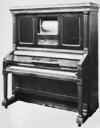- player piano
-
a piano that can play automatically when the keys are actuated electronically or by a pneumatic device controlled by a piano roll.[1900-05, Amer.]
* * *
Piano that mechanically plays music encoded as perforations on a paper roll.An early version, patented in 1897 by the American engineer E.S. Votey, was a cabinet placed in front of an ordinary piano, with wooden "fingers" projecting over the keyboard. A paper roll with perforations corresponding to the notes passed over a tracker bar to activate the release of air by pneumatic devices that set the fingers in motion; the user could control tempo and loudness by levers and pedals. Soon this mechanism was built into the piano itself. The later "reproducing piano" could reproduce the nuances of tempo and dynamics in great performances, the roll having been produced by the performance itself. After the 1920s the phonograph led to the instrument's quick decline. Modern versions, such as the Yamaha Disklavier, are operated by digital memory on a computer disk. Steinway-Welte player piano, 1910; in the British Piano and Musical Museum, Brentford, Middlesex, ...By courtesy of The British Piano and Musical Museum, Brentford, Middlesex, Eng.
Steinway-Welte player piano, 1910; in the British Piano and Musical Museum, Brentford, Middlesex, ...By courtesy of The British Piano and Musical Museum, Brentford, Middlesex, Eng.* * *
a piano that mechanically plays music recorded by means, usually, of perforations on a paper roll or digital memory on a computer disc.In its original form as the Pianola, patented in 1897 by an American engineer, E.S. Votey, the player piano was a cabinet called a “piano player” that was stationed in front of an ordinary piano and had a row of wooden “fingers” projecting over the keyboard. In the cabinet, a paper roll passed over a tracker bar that activated the release of air by pneumatic devices that set in motion the wooden fingers that struck the notes on the keyboard. Later, the mechanism of this cabinet was built into the body of the piano. Levers and pedals in front of the cabinet or cabinet-piano controlled the tempo, the loudness, and other dynamics and accents. The pumping foot-treadle for activating the pneumatic system came to be located under the piano.By careful pedaling of the treadle and careful use of the levers for tempo and other effects, a person relatively unskilled in music could produce somewhat satisfactory music. Player-piano manufacturers, however, eventually obviated even this elementary use of musicianship by incorporating devices into the player-piano roll that could approximate the performing nuances of an artist, including changes of tempo, relative loudness of bass and treble, crescendos, diminuendos, and other dynamics. These highly sophisticated models were known as “reproducing pianos.” In time, reproducing and other player pianos came to be powered by electricity, permitting not only player pianos for the home but also coin-operated pianos for amusement centres and dance halls. Ordinary player pianos were usually uprights, but reproducing pianos were often grands.In the early 20th century, some companies manufactured player-piano rolls that, with a fair amount of accuracy, reproduced performances by such distinguished figures as Alfred Cortot, Claude Debussy, Sergey Rachmaninoff, Artur Rubinstein, and George Gershwin. These performances were played on the reproducing piano, and some of them were later transferred to phonograph records. The player piano also attracted composers, who could write pieces without concern for the limitations of the human hand. Such works include Igor Stravinsky's Étude for Pianola (1917) and Paul Hindemith's Toccata for mechanical piano (1926). The vogue of the traditional player piano declined with the increasing popularity of the radio and phonograph in the 1930s.By the 1990s the Yamaha Corporation, a Japanese piano manufacturer, had introduced the “Disklavier,” an acoustic player piano equipped with a computer that, by reading data on a floppy disc or compact disc, could re-create on the piano virtually every nuance of a performance—the tone, touch, timing, and dynamic range of a real performance. The key-striking and pedaling mechanisms were activated not pneumatically (as of old) but electromagnetically with a series of sensors and solenoids. Besides playing computer discs of performances recorded elsewhere, the Disklavier (and similar machines) could record the notes played manually on its own keyboard and then play them back, thereby enabling piano students and performers to study their own performances on an actual piano rather than a conventional audio system. Disklaviers ranged from simple uprights to the finest concert grands.* * *
Universalium. 2010.
